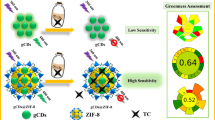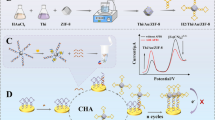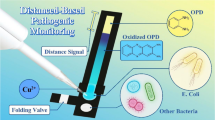Abstract
The authors describe a method for colorimetric determination of Campylobacter jejuni (C. jejuni) in milk samples. It is based on the interaction of a specific DNA aptamer with surface protein in the cell membranes of C. jejuni. Specific binding of the aptamer with the cell membrane leads to an uptake of aptamer from solution. As a result, the concentration of aptamer floating in the solution is reduced. In the presence of large quantities of aptamer, the surface of added Au@Pd nanoparticles (NPs) is covered with aptamer via electrostatic interactions. Hence, they cannot act as a peroxidase mimic and oxidize the substrate 3,3′,5,5′-tetramethylbenzidine (TMB) to give a blue product. However, when the aptamer is bound by the target cells, the surface of the NPs is not blocked by aptamer and the NPs exert a strong peroxidase -like activity. Under defined experimental conditions, the intensity of the blue color increases with the concentration of C. jejuni, and as little as 100 CFU·mL−1 can bedetected in milk.

A colorimetric aptasensor for assay Campylobacter jejuni whole cell in food samples was investigated. This assay was designed based on interaction of specific DNA aptamer with surface protein in c. jejuni cell membrane without any modification of aptamer.





Similar content being viewed by others
References
Bolton DJ (2015) Campylobacter virulence and survival factors. Food Microbiol 48:99–108
Fernández H, Vera F, Villanueva MP (2008) García a. Occurrence of Campylobacter species in healthy well-nourished and malnourished children. Braz J Microbiol 39:1–310
Kaakoush NO, Castaño-Rodríguez N, Mitchell HM, Man SM (2015) Global epidemiology of Campylobacter infection. Clin Microbiol Rev 28:687–720
Yang X, Jeffrey K, Aleksandr S (2013) Campylobacter spp. detection in the 21st century: a review of the recent achievements in biosensor development. J Microbiol Methods 95:148–156
Masdor NA, Altintas Z, Tothill IE (2017) Surface Plasmon resonance Immunosensor for the detection of Campylobacter jejuni. Chemosensors 5:16
Che Y, Li Y, Slavik M (2001) Detection of Campylobacter jejuni in poultry samples using an enzyme-linked immunoassay coupled with an enzyme electrode. Biosens Bioelectron 16:791–797
Platts-Mills JA, Liu J, Gratz J, Mduma E, Amour C, Swai N, Taniuchi M, Begum S, Penataro Yori P, Tilley DH, Lee G, Shen Z, Whary MT, Fox JG, McGrath M, Kosek M, Haque R, Houpt ER (2014) Detection of campylobacter in stool and determination of significance by culture, enzyme immunoassay, and PCR in developing countries. J Clin Microbiol 52:1074–1080
Smith CJ, Osborn AM (2009) Advantages and limitations of quantitative PCR (Q-PCR)-based approaches in microbial ecology. FEMS Microbiol Ecol 67:6–20
Masdor NA, Altintas Z, Tothill IE (2016) Sensitive detection of Campylobacter jejuni using nanoparticles enhanced QCM sensor. Biosens Bioelectron 78:328–336
Ivnitski D, Wilkins E, Tien H, Ottova A (2000) Electrochemical biosensor based on supported planar lipid bilayers for fast detection of pathogenic bacteria. Electrochem Commun 2:457–460
Huang J, Yang G, Meng W, Wu L, Zhu A, Jiao X (2010) An electrochemical impedimetric immunosensor for label-free detection of Campylobacter jejuni in diarrhea patients’ stool based on O-carboxymethylchitosan surface modified Fe3O4 nanoparticles. Biosens Bioelectron 25:1204–1211
Drummond TG, Hill MG, Barton JK (2003) Electrochemical DNA sensors. Nat Biotechnol 21:1192–1199
Bruno John G, Phillips T, Carrillo MP, Crowell R (2009) Plastic-adherent DNA aptamer- magnetic bead and quantum dot sandwich assay for Campylobacter detection. J Fluoresc 19:3427
Dadmehr M, Hosseini M, Hosseinkhani S, Ganjali MR, Sheikhnejad R (2015) Label free colorimetric and fluorimetric direct detection of methylated DNA based on silver nanoclusters for cancer early diagnosis. Biosens Bioelectron 73:108–113
Rahimi-Nasrabadi M, Mizani F, Hosseini M, Homayoun Keihan A, Ganjali MR (2017) Detection of hydrogen peroxide and glucose by using Tb2(MoO4)3 nanoplates as peroxidase mimics. Spectrochim Acta A 186:82–88
Pan N, Li-Ying W, Wu LL, Peng CF, Xie ZJ (2017) Colorimetric determination of cysteine by exploiting its inhibitory action on the peroxidase-like activity of au@Pt core-shell nanohybrids. Microchim Acta 184(1):65–72
Nirala NR, Prakash R (2018) Quick colorimetric determination of choline in milk and serum based on the use of MoS2 nanosheets as a highly active enzyme mimetic. Microchim Acta 185(4):224
Shokri E, Hosseini M, Davari MD, Ganjali MR, Peppelenbosch MP, Rezaee F (2017) Disulfide-induced self-assembled targets: a novel strategy for the label free colorimetric detection of DNAs/RNAs via unmodified gold nanoparticles. Sci Rep 7:45837
Xu HH, Deng HH, Lin XQ, Wu YY, Lin XL, Peng HP et al (2017) Colorimetric glutathione assay based on the peroxidase-like activity of a nanocomposite consisting of platinum nanoparticles and graphene oxide. Microchim Acta 184(10):3945–3951
Borghei YS, Hosseini M, Dadmehr M, Hosseinkhani S, Ganjali MR, Sheikhnejad R (2016) Visual detection of cancer cells by colorimetric aptasensor based on aggregation of gold nanoparticles induced by DNA hybridization. Anal Chim Acta 904:92–97
Huang L, Zhu W, Zhang W, Chen K, Wang J, Wang R et al (2018) Layered vanadium(IV) disulfide nanosheets as a peroxidase-like nanozyme for colorimetric detection of glucose. Microchim Acta 185(1):7
O'sullivan NA, Fallon R, Carroll C, Smith T, Maher M (2000) Detection and differentiation of Campylobacter jejuni and campylobacter coli in broiler chicken samples using a PCR/DNA probe membrane based colorimetric detection assay. Mol Cell Probes 14:17–16
Wuttichote J, Jangpatarapongsa K, Polpanich D, Wonglumsom W (2016) Detection of Campylobacter DNA using magnetic nanoparticles coupled with PCR and a colorimetric end-point system. Food Sci Biotechnol 1:193–198
Zhang Y, Chu W, Dibaji Foroushani A, Wang H, Li D, Liu J, Barrow CJ, Wang X, Yang W (2014) New gold nanostructures for sensor applications: a review. Materials 7:5169–5201
Wei H, Wang E (2013) Nanomaterials with enzyme-like characteristics (nanozymes): next-generation artificial enzymes. Chem Soc Rev 42:6060–6093
Park JY, Jeong HY, Kim MI, Park TJ (2015) Colorimetric detection system for Salmonella typhimurium based on peroxidase-like activity of magnetic nanoparticles with DNA aptamers. J Nanomater 2015:2
Gao F, Goodman DW (2012) Pd–au bimetallic catalysts: understanding alloy effects from planar models and (supported) nanoparticles. Chem Soc Rev 41(24):8009–8020
Shahsavar K, Hosseini M, Shokri E, Ganjali MR, Ju H (2017) A sensitive colorimetric aptasensor with a triple-helix molecular switch based on peroxidase-like activity of a DNAzyme for ATP detection. Anal Methods 9:4726–4731
Hosseini M, Sabet FS, Khabbaz H, Aghazadeh M, Mizani F, Ganjali MR (2017) Enhancement of the peroxidase-like activity of cerium-doped ferrite nanoparticles for colorimetric detection of H2O2 and glucose. Anal Methods 9:3519–3524
Choleva TG, Gatselou VA, Tsogas GZ, Giokas DL (2018) Intrinsic peroxidase-like activity of rhodium nanoparticles, and their application to the colorimetric determination of hydrogen peroxide and glucose. Microchim Acta 185(1):22
Hosseini M, Aghazadeh M, Ganjali MR (2017) A facile one-pot synthesis of cobalt-doped magnetite/graphene nanocomposite as peroxidase mimetics in dopamine detection. New J Chem 41:12678–12684
Yan J, Huang Y, Zhang C, Fang Z, Bai W, Yan M et al (2017) Aptamer based photometric assay for the antibiotic sulfadimethoxine based on the inhibition and reactivation of the peroxidase-like activity of gold nanoparticles. Microchim Acta 184(1):59–63
Dadmehr M, Hosseini M, Hosseinkhani S, Ganjali MR, Khoobi M, Behzadi H, Hamedani M, Sheikhnejad R (2014) DNA methylation detection by a novel fluorimetric nanobiosensor for early cancer diagnosis. Biosens Bioelectron 15:35–44
Su H, Zhao H, Qiao F, Chen L, Duan R, Ai S (2013) Colorimetric detection of Escherichia coli O157: H7 using functionalized au@ Pt nanoparticles as peroxidase mimetics. Analyst 138:3026–3031
Sun Z, Zhao Q, Zhang G, Li Y, Zhang G, Zhang F, Fan X (2015) Exfoliated MoS 2 supported au–Pd bimetallic nanoparticles with core–shell structures and superior peroxidase-like activities. RSC Adv 5:10352–10357
Guo A, Wu D, Ma H, Zhang Y, Li H, Du B, Wei Q (2013) An ultrasensitive enzyme-free electrochemical immunosensor for CA125 using au@ Pd core–shell nanoparticles as labels and platforms for signal amplification. J Mater Chem B 1:4052–4058
Dwivedi HP, Derike Smiley R, Jaykus LA (2010) Selection and characterization of DNA aptamers with binding selectivity to Campylobacter jejuni using whole-cell SELEX. Appl Microbiol Biotechnol 87:2323–2334
Kimling J, Maier M, Okenve B, Kotaidis V, Ballot H, Plech A (2006) Turkevich method for gold nanoparticle synthesis revisited. J Phys Chem 110:15700–15707
Yang L, Liu X, Lu Q, Huang N, Liu M, Zhang Y, Yao S (2016) Catalytic and peroxidase-like activity of carbon based-AuPd bimetallic nanocomposite produced using carbon dots as the reductant. Anal Chim Acta 930:23–30
Verma J, Saxena S, Babu SG (2013) ELISA-based identification and detection of microbes. In: Arora D, Das S, Sukumar M (eds) Analyzing microbes. Springer, Berlin, Heidelberg, p 169–186
Chen D, Li C, Liu H, Ye F, Yang J (2015) Core-shell au@ Pd nanoparticles with enhanced catalytic activity for oxygen reduction reaction via core-shell au@ ag/Pd constructions. Sci Rep 5:11949
Tedsree K, Li T, Jones S, Chan CWA, Yu KMK, Bagot PA, Marquis EA, Smith GD, Tsang SCE (2011) Hydrogen production from formic acid decomposition at room temperature using a ag–Pd core–shell nanocatalyst. Nat Nanotechnol 6(5):302–307
Chen H, Li Y, Zhang F, Zhang G, Fan X (2011) Graphene supported au-Pd bimetallic nanoparticles with core-shell structures and superior peroxidase-like activities. J Mater Chem 21:17658–17661
Yarbakht M, Nikkhah M (2016) Unmodified gold nanoparticles as a colorimetric probe for visual methamphetamine detection. J Exp Nanosci 11(7):593–601
Bruno JG, Sivils JC (2017) Further characterization and independent validation of a DNA aptamer-quantum dot-based magnetic sandwich assay for Campylobacter. Folia Microbiol 1–6
An H, Jin B (2012) Prospects of nanoparticle–DNA binding and its implications in medical biotechnology. Biotechnol Adv 30:1721–1732
Wang H, Li Y, Slavik M (2014) Rapid detection of Campylobacter jejuni in poultry products using quantum dots and nanobeads based fluorescent immunoassay. Int J Poult Sci 13:253–259
Suh SH, Dwivedi HP, Jaykus LA (2014) Development and evaluation of aptamer magnetic capture assay in conjunction with real-time PCR for detection of Campylobacter jejuni. LWT Food Sci Technol 56:256–260
Acknowledgements
The authors thank the research Council of University of Tehran (Grant 28645/01/02) and Tehran University of Medical Sciences for financial support of this work.
Author information
Authors and Affiliations
Corresponding author
Ethics declarations
The author(s) declare that they have no competing interests.
Electronic supplementary material
ESM 1
(DOCX 368 kb)
Rights and permissions
About this article
Cite this article
Dehghani, Z., Hosseini, M., Mohammadnejad, J. et al. Colorimetric aptasensor for Campylobacter jejuni cells by exploiting the peroxidase like activity of Au@Pd nanoparticles. Microchim Acta 185, 448 (2018). https://doi.org/10.1007/s00604-018-2976-2
Received:
Accepted:
Published:
DOI: https://doi.org/10.1007/s00604-018-2976-2




